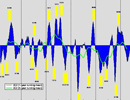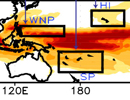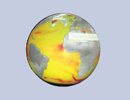GPCP merged monthly precipitation, V2.2 / V2.3
The Global Precipitation Climatology Project (GPCP) was established by the World Climate Research Program (WCRP) to address the problem of quantifying the distribution of precipitation around the globe over many years. The general approach is to combine the precipitation information available from each of several sources into a final merged product, taking advantage of the strengths of each data type. The microwave estimates are based on Special Sensor Microwave/Imager (SSM/I) data from the Defense Meteorological Satellite Program (DMSP, United States) satellites that fly in sun-synchronous low-earth orbits. The infrared (IR) precipitation estimates are computed primarily from geostationary satellites (United States, Europe, Japan), and secondarily from polar-orbiting satellites (United States). Additional low-Earth orbit estimates include the Atmospheric Infrared Sounder (AIRS data from the NASA Aqua, and Television Infrared Observation Satellite Program (TIROS) Operational Vertical Sounder (TOVS) and Outgoing Longwave Radiation Precipitation Index (OPI) data from the NOAA series satellites. The gauge data are assembled and analyzed by the Global Precipitation Climatology Centre (GPCC) of the Deutscher Wetterdienst and by the Climate Prediction Center of NOAA.
The GPCP has promoted the development of an analysis procedure for blending the various estimates together to produce the necessary global gridded precipitation fields. The currently operational procedure is described in Adler et al (2003) and Huffman et al (2009) and has been used to produce the GPCP Version 2.2 Combined Precipitation Data Set, covering the period January 1979 through the present (with some delay). The primary product in the Version 2.2 dataset is a combined observation-only dataset, that is, a gridded analysis based on gauge measurements and satellite estimates of rainfall. There are a total of 27 fields in the data set providing information from the individual and intermediate estimates, including estimates of RMS random error. A new Version 2.3 has been released in 2016. A daily product (Huffman et al., 2001) is available starting in late 1997 and a pentad product is available from 1979 to the near present (Xie et al., 2003).
The data set archive consists of yearly unformatted REAL*4 binary files with ASCII headers, each of which holds 12 monthly fields. Each file occupies almost 0.5 MB. The grid on which each field of values is presented is a 2.5°x2.5° latitude--longitude (Cylindrical Equal Distance) global array of points. It is size 144x72, with X (longitude) incrementing most rapidly West to East from the Prime Meridian, and then Y (latitude) incrementing North to South. Grid edges are placed on whole- and half-degree values:
First point center = (88.75°N,1.25°E)
Second point center = (88.75°N,3.75°E)
Last point center = (88.75°S,1.25°W)
Missing values are denoted by the value -99999., and the units on the fields depend on the variable. For example, rainfall is carried as mm/day.
References:
Adler, R. F., G. J. Huffman, A. Chang, R. Ferraro, P. Xie, J. Janowiak, B. Rudolf, U. Schneider, S. Curtis, D. Bolvin, A. Gruber, J. Susskind, P. Arkin, and E. Nelkin, 2003: The version 2 Global Precipitation Climatology Project (GPCP) monthly precipitation analysis (1979-present). J. Hydrometeor, 4(6), 1147-1167. doi:10.1175/1525-7541(2003)004<1147:TVGPCP>2.0.CO;2.
Adler, R. F., G. Gu, and G. Huffman, 2012. Estimating Climatological Bias Errors for the Global Precipitation Climatology Project (GPCP). Journal of Applied Meteorology and Climatology, 51, 84-99.doi:10.1175/JAMC-D-11-052.1.
Adler et al., 2016. An Update (Version 2.3) of the GPCP Monthly Analysis. (in Preparation).
Huffman, G.J., R.F. Adler, P. Arkin, A. Chang, R. Ferraro, A. Gruber, J. Janowiak, A. McNab, B. Rudolf, U. Schneider, 1997: The Global Precipitation Climatology Project (GPCP) Combined Precipitation Dataset. Bull. Amer. Meteor. Soc., 78(1), 5-20. doi:10.1175/1520-0477(1997)078<0005:TGPCPG>2.0.CO;2.
Huffman, G. J., R. F. Adler, D. T. Bolvin, and G. Gu (2009): Improving the global precipitation record: GPCP Version 2.1, Geophys. Res. Lett., 36, L17808, doi:10.1029/2009GL040000.
Schneider, Udo; Becker, Andreas; Finger, Peter; Meyer-Christoffer, Anja; Rudolf, Bruno; Ziese, Markus (2015a): GPCC Full Data Reanalysis Version 7.0 at 0.5°: Monthly Land-Surface Precipitation from Rain-Gauges built on GTS-based and Historic Data. doi:10.5676/DWD_GPCC/FD_M_V7_050.
Schneider, Udo; Becker, Andreas; Finger, Peter; Meyer-Christoffer, Anja; Rudolf, Bruno; Ziese, Markus (2015b): GPCC Monitoring Product: Near Real-Time Monthly Land-Surface Precipitation from Rain-Gauges based on SYNOP and CLIMAT data. doi:10.5676/DWD_GPCC/MP_M_V5_100.
| Variables | merged precipitation (mm/day), precipitation error (mm/day) |
| Zonal | Global by 2.5 deg |
| Meridional | Global by 2.5 deg |
| Vertical | surface |
| Temporal | V2.2 (old): Jan 1979 to Dec 2011 by 1 month V2.2: Jan 1979 to Oct 2015 by 1 month V2.3: Jan 1979 to Feb 2018 by 1 month |
| Static? | no |
| Volume | 0.5 Mbytes per year |
| Server | public:      |
| Source | http://precip.gsfc.nasa.gov/ http://gpcp.umd.edu |
| Acquired | Mar 10, 2005 (Updated Jun 2018) |
| APDRC contact | |
| Supplements | gpcp_monthly.f gpcp_monthly.pdf GPCPmonthlyV2.3.pdf |































